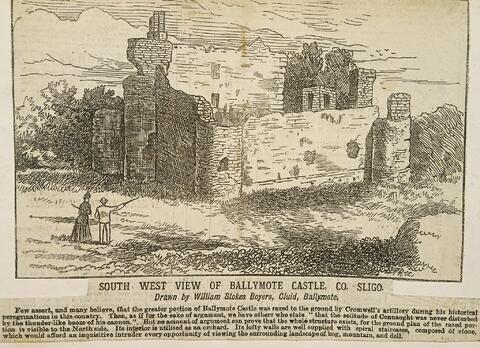Código de referência
Título
Data(s)
- c.1895 (Produção)
Nível de descrição
Dimensão e suporte
1 p.; clipping
Nome do produtor
Entidade detentora
História do arquivo
Fonte imediata de aquisição ou transferência
Âmbito e conteúdo
A clipping of an article on Ballymote Castle in County Sligo. The drawing is by William Stokes Boyers.
Avaliação, seleção e eliminação
Incorporações
Sistema de arranjo
Condições de acesso
Condiçoes de reprodução
Idioma do material
Sistema de escrita do material
Notas ao idioma e script
Características físicas e requisitos técnicos
Instrumentos de descrição
Existência e localização de originais
Existência e localização de cópias
Unidades de descrição relacionadas
Nota
Built in the late twelfth century, the castle is an impressive Anglo-Norman fortification and one of the strongest fortresses of its era constructed in Connacht. It is believed to have been built by Richard de Burgh (c.1259-1326), 2nd Earl of Ulster, a friend of King Edward I (Edward Longshanks) of England, and one of the most powerful Norman lords of the period. As alluded to in the original caption, the castle has had a varied history of attack and destruction, changing hands several times between Gaelic clans and English forces.
It was from Ballymote that Aodh Ruadh Ó Domhnaill (Red Hugh O’Donnell) marched to the disastrous Battle of Kinsale in late 1601. It was subsequently surrendered to the victorious Crown forces under Charles Blount (Lord Mountjoy). In the seventeenth century, the castle was subjected to yet more military assaults and was finally abandoned in the 1690s. Over time, it fell into complete ruin. Ballymote Castle is now a designated national monument and is maintained by the Office of Public Works.

